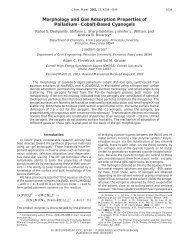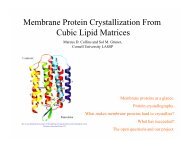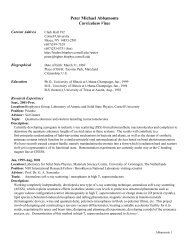Pixel Array Detector for Single Particle Scattering - Gruner Group
Pixel Array Detector for Single Particle Scattering - Gruner Group
Pixel Array Detector for Single Particle Scattering - Gruner Group
Create successful ePaper yourself
Turn your PDF publications into a flip-book with our unique Google optimized e-Paper software.
<strong>Pixel</strong> <strong>Array</strong> <strong>Detector</strong><br />
<strong>for</strong> <strong>Single</strong> <strong>Particle</strong> <strong>Scattering</strong><br />
Hugh Philipp<br />
9. Feb. 2006<br />
LCLS – PAD Talk<br />
1
Outline<br />
●<br />
●<br />
●<br />
●<br />
●<br />
●<br />
<strong>Pixel</strong> <strong>Array</strong> <strong>Detector</strong>s: General Background.<br />
– Basic structure, diode, ASIC, bump-bonding.<br />
Specific requirements <strong>for</strong> LCLS PAD detector.<br />
– Noise, frame rate, efficiency, RAD hardness.<br />
Approach used in the first prototype.<br />
– front-end and pixel architecture.<br />
Test results from first prototype.<br />
Plans <strong>for</strong> next submission (second prototype).<br />
Conclusions and future.<br />
Hugh Philipp<br />
9. Feb. 2006<br />
LCLS – PAD Talk<br />
2
<strong>Pixel</strong> <strong>Array</strong> <strong>Detector</strong>s<br />
●<br />
Basic structure<br />
●<br />
High resistivity Si<br />
diode <strong>for</strong> direct x-ray<br />
conversion.<br />
●<br />
Solder or indium<br />
bump-bonding<br />
connection to CMOS<br />
ASIC.<br />
●<br />
CMOS ASIC uses<br />
high-quality<br />
commercial mixedmode<br />
process 0.25 µm<br />
process.<br />
Hugh Philipp<br />
9. Feb. 2006<br />
LCLS – PAD Talk<br />
3
<strong>Detector</strong> Diode - Basics<br />
Incident X-rays<br />
●<br />
●<br />
●<br />
●<br />
●<br />
Diode: direct<br />
conversion of x-rays.<br />
300 m thick silicon.<br />
Reverse biased <strong>for</strong> full<br />
depletion.<br />
~2200 e-/hole pairs per<br />
8 keV x-ray.<br />
Conversion noise<br />
dictated by Fano factor.<br />
Hugh Philipp<br />
9. Feb. 2006<br />
LCLS – PAD Talk<br />
4
Diode<br />
Efficiency<br />
●<br />
Calculated quantum efficiency of diode detector<br />
using conservative assumptions.<br />
Quantum Efficiency<br />
(photon converted/photons incident)<br />
90%<br />
determined by<br />
Si absorption length<br />
The diode is a good match to 4-8 keV range.<br />
4 6 8 10 12 14<br />
300 µm<br />
Al thin film used<br />
<strong>for</strong> applying bias<br />
Si Diode<br />
bump side<br />
Values calculated<br />
<strong>for</strong> x-rays with<br />
normal incidence.<br />
Photon Energy (keV)<br />
Hugh Philipp<br />
9. Feb. 2006<br />
LCLS – PAD Talk<br />
5
ASIC basics<br />
Bonding Pads <strong>for</strong> I/O & power.<br />
●<br />
●<br />
●<br />
●<br />
●<br />
●<br />
CMOS based.<br />
<strong>Pixel</strong>s between 100 and<br />
200 µm square in previous<br />
detectors.<br />
Commercial Process<br />
(TSMC 0.25 µm).<br />
Limit on size: 21mm<br />
square – single FOV.<br />
Top side PAD connections<br />
<strong>for</strong> I/O, power, and<br />
bumping to diode.<br />
3-side buttable.<br />
Hugh Philipp<br />
9. Feb. 2006<br />
LCLS – PAD Talk<br />
6
ASIC – pixel front-end<br />
●<br />
●<br />
●<br />
●<br />
Analog PAD's integrate<br />
charge.<br />
Charge is well defined<br />
per unit x-ray.<br />
Good at handling split<br />
events between pixel.<br />
AND – Needed <strong>for</strong> high<br />
flux measurements!!<br />
( i.e. when photons come faster<br />
than you can count! )<br />
First LCLS-prototype single-stage folded<br />
cascode front-end op-amp.<br />
Hugh Philipp<br />
9. Feb. 2006<br />
LCLS – PAD Talk<br />
7
ASIC<br />
Mixed Mode<br />
●<br />
Mixed mode CMOS process<br />
– TSMC 0.25 µm process used in mobile phones.<br />
●<br />
Allows monolithic combination of analog and digital<br />
circuits.<br />
– essentially by including high-quality metal-oxidemetal<br />
capacitors in the process.<br />
●<br />
Some inherent radiation hardness.<br />
Hugh Philipp<br />
9. Feb. 2006<br />
LCLS – PAD Talk<br />
8
Bump-bonding<br />
●<br />
Typically solder or<br />
indium bumping.<br />
●<br />
Critical step <strong>for</strong> the<br />
detector.<br />
●<br />
There are standard<br />
processes used in<br />
industry.<br />
Above: Bumping test<br />
structures.<br />
●<br />
Difficult <strong>for</strong> small<br />
volume research to do<br />
it <strong>for</strong> reasonable cost.<br />
Hugh Philipp<br />
9. Feb. 2006<br />
LCLS – PAD Talk<br />
9
<strong>Single</strong> <strong>Particle</strong><br />
<strong>Scattering</strong><br />
●<br />
Intense femtosecond<br />
pulses.<br />
●<br />
120 Hz frame rate.<br />
●<br />
<strong>Single</strong> photon<br />
sensitivity.<br />
Hugh Philipp<br />
9. Feb. 2006<br />
LCLS – PAD Talk<br />
10
LCLS <strong>Detector</strong><br />
Requirements<br />
The question:<br />
<strong>for</strong> single 8 keV photon<br />
●<br />
Given these specs, how<br />
do we get the<br />
per<strong>for</strong>mance we want<br />
in a PAD?<br />
●<br />
●<br />
Some are addressed by<br />
the diode: DQE, Energy<br />
range.<br />
500x500 means tiling is<br />
necessary.<br />
Hugh Philipp<br />
9. Feb. 2006<br />
LCLS – PAD Talk<br />
11
LCLS <strong>Detector</strong><br />
Requirements<br />
*<br />
diode<br />
set by int. cap.*<br />
<strong>for</strong> single 8 keV photon<br />
<strong>for</strong> N p<br />
= number of photons = 1000<br />
The question:<br />
enough <strong>for</strong> electronics to fit in.<br />
Requires tiling<br />
●<br />
●<br />
●<br />
Given these specs, how<br />
do we get the<br />
per<strong>for</strong>mance we want<br />
in a PAD?<br />
Some are addressed by<br />
the diode: DQE, Energy<br />
range.<br />
500x500 means tiling is<br />
necessary.<br />
Hugh Philipp<br />
9. Feb. 2006<br />
LCLS – PAD Talk<br />
12
High-level layout<br />
of LCLS pixel<br />
●<br />
In-pixel digitization<br />
using single-slope<br />
ramp (externally<br />
supplied).<br />
C f<br />
Simplified High-level view of proposed pixel<br />
●<br />
Each pixel converts<br />
independently and<br />
in parallel.<br />
●<br />
Eliminates fast<br />
analog multiplexing.<br />
<strong>Pixel</strong> similar to that in: S. Kleinfelder, S. Lim, X. Liu, and A. Gamal, “A 10000<br />
Frames/s CMOS Digital <strong>Pixel</strong> Sensor”, IEEE J. of Solid-State Circuits, vol.<br />
36, no. 12, Dec. 2001.<br />
Hugh Philipp<br />
9. Feb. 2006<br />
LCLS – PAD Talk<br />
13
High-level layout<br />
of LCLS pixel<br />
●<br />
Makes slow, lowbandwidth<br />
ADC<br />
possible.<br />
C f<br />
●<br />
Keeps pixel level<br />
electronics simple.<br />
●<br />
Only digital output.<br />
Simplified High-level view of proposed pixel<br />
<strong>Pixel</strong> similar to that in: S. Kleinfelder, S. Lim, X. Liu, and A. Gamal, “A 10000<br />
Frames/s CMOS Digital <strong>Pixel</strong> Sensor”, IEEE J. of Solid-State Circuits, vol.<br />
36, no. 12, Dec. 2001.<br />
Hugh Philipp<br />
9. Feb. 2006<br />
●<br />
Easily adjustable<br />
input ramp.<br />
●<br />
120 Hz frame rate.<br />
LCLS – PAD Talk<br />
14
Digitization Scheme<br />
Digitize<br />
(wave<strong>for</strong>ms)<br />
Read Data<br />
Reset <strong>Pixel</strong><br />
XFEL<br />
pulse<br />
Digitize<br />
Read Data<br />
Reset <strong>Pixel</strong><br />
XFEL<br />
pulse<br />
Full period ~8.3ms<br />
Basic idea: Take on the order of ms to digitize,<br />
then read out the data as fast as you can.<br />
Hugh Philipp<br />
9. Feb. 2006<br />
LCLS – PAD Talk<br />
15
<strong>Pixel</strong> Design<br />
general comments<br />
●<br />
In-pixel single-slope ramp<br />
ADC.<br />
●<br />
CDS stage has low<br />
bandwidth buffer.<br />
●<br />
Latched output on the<br />
comparator.<br />
●<br />
Relatively slow comparator.<br />
●<br />
12-bit counter/ shift-register.<br />
●<br />
Parallel conversion of pixels.<br />
●<br />
Programmable multiple-gain<br />
techniques available.<br />
Hugh Philipp<br />
9. Feb. 2006<br />
LCLS – PAD Talk<br />
16
●<br />
Digital Feedthrough Isolation<br />
and more comments on approach<br />
Noise injection to analog front-end from<br />
digital clock.<br />
What we are doing to reduce this:<br />
●<br />
●<br />
●<br />
●<br />
●<br />
Full separation of anlog and digital power on chip.<br />
Low bandwidth buffer input to comparator.<br />
Highly shielded ramp signal.<br />
Slow comparator.<br />
Latched comparator output.<br />
Hugh Philipp<br />
9. Feb. 2006<br />
LCLS – PAD Talk<br />
17
Power Layout<br />
Vdda<br />
gnda<br />
Analog<br />
Digital<br />
Vddd<br />
gndd<br />
●<br />
Digital and power<br />
separated on chip.<br />
Substrate<br />
●<br />
No DC connections<br />
between analog and<br />
digital power on chip.<br />
Analog<br />
Digital<br />
Analog<br />
●<br />
Still AC coupling<br />
through substrate.<br />
B<br />
C<br />
A<br />
counter<br />
digital bus<br />
counter<br />
A: Front End Amp.<br />
B: CDS Buffer.<br />
C: Comparator.<br />
digital/analog division in adjacent mirrored pixels (LCLS proto-1)<br />
Hugh Philipp<br />
9. Feb. 2006<br />
LCLS – PAD Talk<br />
18
Buffer, Comparator and Ramp<br />
(the heart of the ADC)<br />
●<br />
Low bandwidth<br />
elements:<br />
– Buffer: ~1 Mhz<br />
Low bandwidth<br />
elements<br />
Heavily shielded<br />
Ramp signal<br />
(externally supplied and adjustable)<br />
●<br />
(unity gain bw)<br />
– Comparator: < 1 MHz<br />
Heavily shielded ramp:<br />
– dedicated shield<br />
pads.<br />
– versatile wave<strong>for</strong>m.<br />
Hugh Philipp<br />
9. Feb. 2006<br />
LCLS – PAD Talk<br />
19
Well Depth<br />
and Multiple Gain<br />
C f1<br />
C f2<br />
●<br />
●<br />
●<br />
In-pixel memory to set<br />
gain bit.<br />
C f1<br />
– e.g. 50fF.<br />
– High gain full-well.<br />
300 x-rays<br />
7mV/x-ray.<br />
C f2<br />
– e.g. 350 fF<br />
– low gain full-well<br />
2.5k x-rays.<br />
Hugh Philipp<br />
9. Feb. 2006<br />
LCLS – PAD Talk<br />
20
Radiation Hardness<br />
●<br />
Two major CMOS<br />
effects:<br />
– leakage currents in<br />
NMOS switches.<br />
– Threshold voltage<br />
shifts.<br />
● Thinner oxides in 0.25<br />
µm help.<br />
●<br />
Diode damage<br />
Enclosed Layout Transistor<br />
– leakage not a problem with<br />
short exposures.<br />
Hugh Philipp<br />
9. Feb. 2006<br />
LCLS – PAD Talk<br />
21
Tiling<br />
XFEL direct beam path<br />
- Planar tiling of PADs.<br />
- Some non-active area.<br />
Tiling of<br />
PADs<br />
bonding pads<br />
not to scale<br />
Hugh Philipp<br />
9. Feb. 2006<br />
LCLS – PAD Talk<br />
22
First Prototype<br />
Measurements<br />
counter test<br />
●<br />
Comparator.<br />
4x4 test array<br />
●<br />
●<br />
●<br />
●<br />
Front-end amplifier.<br />
Counter.<br />
Multiple gain.<br />
Digitization.<br />
digitization<br />
test<br />
Multi-gain<br />
test struct.<br />
comparator test<br />
test pixel<br />
Hugh Philipp<br />
9. Feb. 2006<br />
LCLS – PAD Talk<br />
23
Comparator (slide 1)<br />
●<br />
Two important<br />
characteristics:<br />
– Noise.<br />
– Switching time<br />
proportional to<br />
voltage.<br />
shown working with<br />
over filtered ramp signal<br />
(ramp time ~4ms here)<br />
Hugh Philipp<br />
9. Feb. 2006<br />
LCLS – PAD Talk<br />
24
Comparator (slide 2)<br />
flipping...<br />
20ns scaling, sharp rise time.<br />
Hugh Philipp<br />
9. Feb. 2006<br />
LCLS – PAD Talk<br />
25
Comparator<br />
(slide 3)<br />
●<br />
Linearity test – time of<br />
transition vs. input<br />
voltage<br />
Linear to resolution of voltage<br />
source – voltage range 0.25-2.25<br />
Hugh Philipp<br />
9. Feb. 2006<br />
LCLS – PAD Talk<br />
26
Comparator<br />
jitter (slide 4)<br />
number of sample in bin<br />
<strong>for</strong> 3 ms ramp -><br />
Time of switch (ns)<br />
time<br />
= 57 ns or ~60 µV<br />
Hugh Philipp<br />
9. Feb. 2006<br />
LCLS – PAD Talk<br />
27
Counter<br />
●<br />
●<br />
●<br />
12-bit in-pixel.<br />
it counts!<br />
it shifts data out!<br />
– tested to 30 MHz (max. freq.<br />
of sig. generator)<br />
– Should go much faster<br />
(100's MHz)<br />
Hugh Philipp<br />
9. Feb. 2006<br />
LCLS – PAD Talk<br />
28
Digitization test (slide 1)<br />
Test Circuit<br />
comparator<br />
logic<br />
counter<br />
ramp ctl.<br />
wave<strong>for</strong>ms<br />
at ~125Hz,<br />
2ms ramp<br />
ramp<br />
{2 12 pulses<br />
Hugh Philipp<br />
9. Feb. 2006<br />
LCLS – PAD Talk<br />
29
Digitization test<br />
(slide 2)<br />
2.25V<br />
adu<br />
~ 1.<br />
4<br />
V<br />
~ 1.<br />
0 mV<br />
end of<br />
ramp<br />
ADU<br />
beginning<br />
of ramp<br />
ADU<br />
(note- 2 ms conversion ramp time)<br />
Voltage Digitized<br />
Digitization looks promising at 12-bits. More work to be done -<br />
possibly stabalizing ramp.<br />
Hugh Philipp<br />
9. Feb. 2006<br />
LCLS – PAD Talk<br />
30
Next Submission<br />
(preliminary plans)<br />
●<br />
●<br />
Add enclosed layout transistors.<br />
Have a test structure to test correlated double sampling.<br />
●<br />
Build larger array (e.g. 10 x 10).<br />
●<br />
●<br />
●<br />
Refine pixel read out circuitry.<br />
<strong>Pixel</strong> addressing logic.<br />
Incorporate multiple gain into test pixel.<br />
Hugh Philipp<br />
9. Feb. 2006<br />
LCLS – PAD Talk<br />
31
Conclusions<br />
●<br />
●<br />
●<br />
●<br />
●<br />
A pixel architecture has been defined <strong>for</strong> in-pixel<br />
digitization.<br />
The first prototype has indicated that the<br />
general approach is workable.<br />
The scalability of the method (i.e. massively<br />
parallel conversion) must be tested.<br />
Tiling of the array detectors is being examined.<br />
Solutions <strong>for</strong> bump-bonding being pursued.<br />
●<br />
Generally: Things are looking good. No “brick<br />
walls” yet.<br />
Hugh Philipp<br />
9. Feb. 2006<br />
LCLS – PAD Talk<br />
32
Thanks<br />
●<br />
This work has been built upon a foundation of many years of<br />
development of PAD detectors in the <strong>Gruner</strong> <strong>Group</strong>. The<br />
present PAD group includes:<br />
– Sol M. <strong>Gruner</strong><br />
– Mark W. Tate<br />
– Lucas J. Koerner<br />
– Daniel R. Schuette<br />
– Alper Ercan<br />
– Darol Chamberlain<br />
– Darren Southworth<br />
– Thomas Caswell<br />
– and ... Hugh Philipp ...<br />
Hugh Philipp<br />
9. Feb. 2006<br />
LCLS – PAD Talk<br />
33









